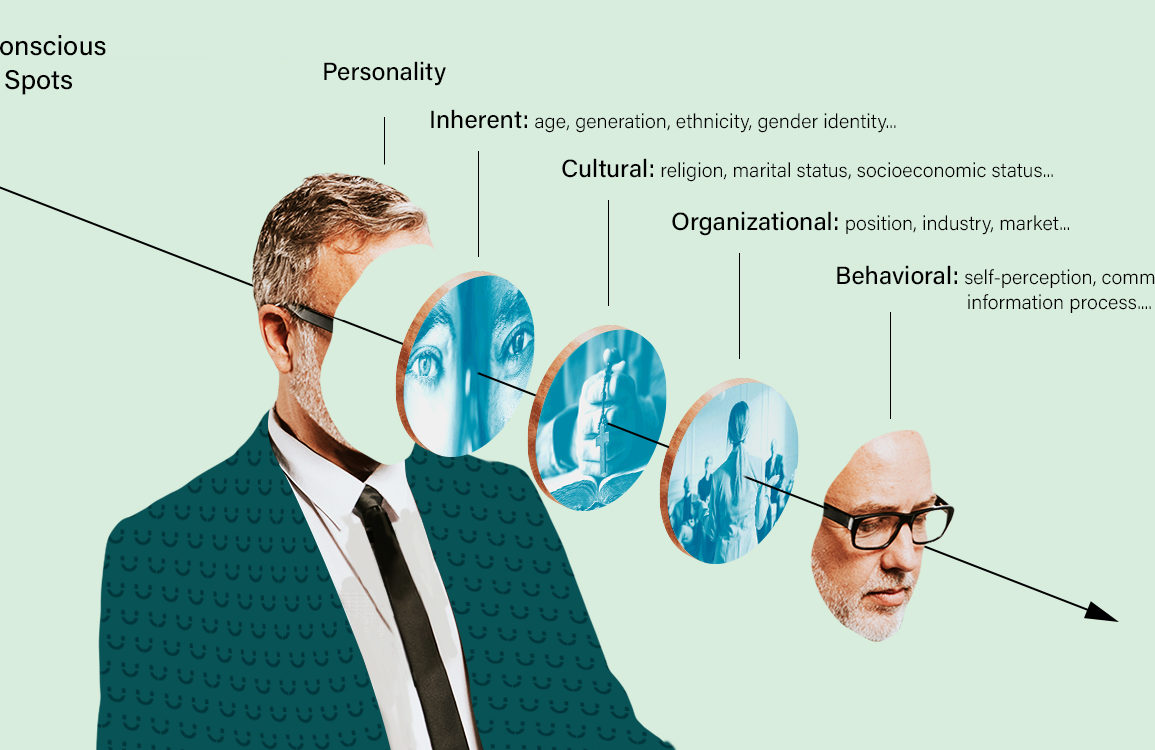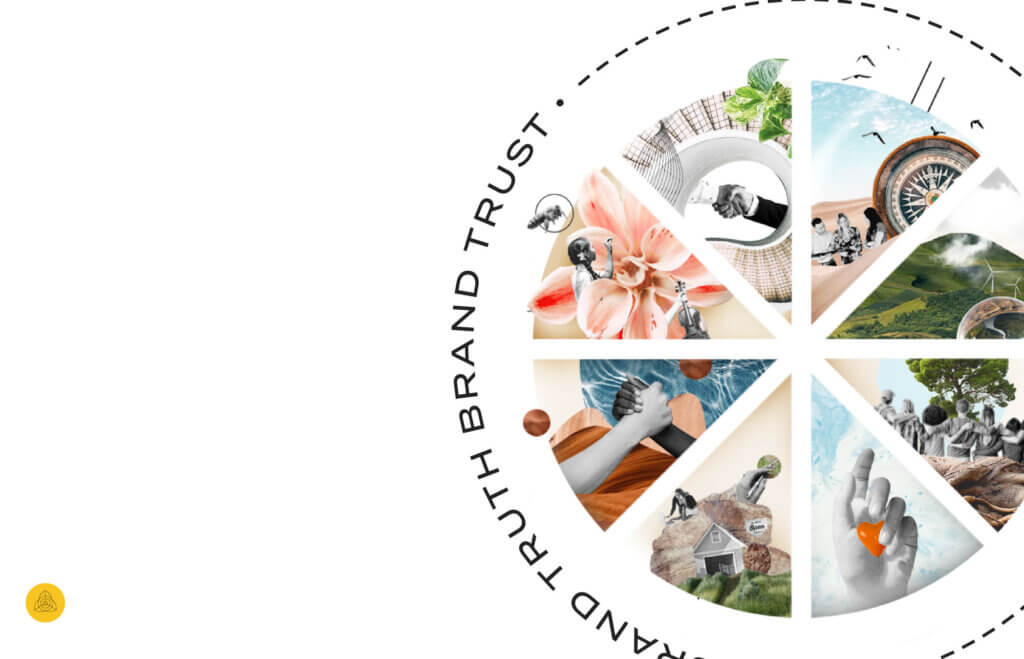Demystifying Unconscious Bias for Marketers

Personality Unconscious Bias

Some biases can be a natural result of your personality. Maybe you’re so extroverted that you pity someone spending a quiet night at home, even when they’re perfectly content to do so.
One theory, the Process Communication Model (PCM), describes six personality types. Although everyone has aspects of all six, the model holds that some of these traits are more dominant than others in each person. Author and PCM trainer Nate Regier says that each base personality type comes with its own unconscious bias. That means that while we’re each susceptible to these personality blind spots, some may resonate with you more than others.
- The Promoter values action, adaptability, and self-sufficiency.
- Unconscious bias: They may look down on those who avoid risk, don’t take action, and struggle to adapt to new situations. They may see others as weak.
- The Thinker views the world through data and information.
- Unconscious bias: They prefer people who are analytical and organized. The thinker may look down on those who rely on instinct or guesswork, or people who are often late. They might think others can’t think clearly.
- The Rebel loves creativity and excitement.
- Unconscious bias: They favor those who are spontaneous and playful. They may be biased toward those who enjoy established routines or see others as boring.
- The Harmonizer prizes relationships and compassion; they are nurtures.
- Unconscious bias: They like people who are compassionate, sensitive, and warm. They may not understand people who aren’t emotional, or they feel others don’t care.
- The Persister sees through the lens of opinion and prizes commitment to values.
- Unconscious bias: They favor people who are dedicated and conscientious. They may look down on those who easily change their minds and may feel others aren’t committed.
- The Imaginer prizes privacy and likes to reflect on the possibilities.
- Unconscious bias: They appreciate those who provide a chance to reflect, and may look down on those who are talkative and surround themselves with others at all times. They may feel others just aren’t aware of what’s really going on under the surface and see them as shallow.
Do you feel you’re stronger in some of these personality traits than others? How might that affect your biases in marketing to them?
Visible Characteristics Unconscious Bias

Biases based on visible characteristics include those centered on race, gender, ethnicity, age, sexual orientation, gender identity, physical ability, and gender expression. They are generally “in your face,” in that you can clearly see the color of someone’s skin, how old they are, etc.
Sexual orientation may not be as openly visible, but we may judge others’ orientation based on the way they are dressed or their mannerisms.
Let’s take these each in turn. Do you recognize yourself, an employee, or a vendor? Because some of these terms can be confused with each other, it’s important to have at least some core definitions as a starting point.
- Race bias can be conscious or unconscious. It can be individual or institutional.
- Individual racism, according to the American Psychological Association (APA), is “a personal belief in the superiority of one’s race over another. It is linked to racial prejudice and discriminatory behaviors, which can be an expression of implicit and explicit bias.”
- Institutional racism is “a system of assigning value and allocating opportunity based on skin color,” says the APA. It gives some individuals and groups an unfair privilege.In the business world, it can be seen in disparities in employment, salary, and opportunities for advancement. It can be expressed implicitly or explicitly and occurs when a group is discriminated against based on race. For example, you might see only white people in upper management.
- Gender bias is a preference or prejudice toward one gender over the other. It can manifest in many ways, both subtle and obvious, according to job posting site Diversity.com. Examples of gender bias in business include wage disparities among different genders doing the same job with the same qualifications, and leadership roles primarily filled by one gender.
- Ethnic bias is defined by cultural heritage. Ethnicity is often confused with race, but it’s not the same thing. Someone might be white, for example, but their ethnicity is Jewish or Polish. Race is a social construct that brings together skin color, heritage, and historical context.
- Age/generational bias is when people in positions of power make assumptions or decisions based on someone’s age or generation.
- Gender identity refers to a person’s internal sense of being male, female, or something else. Gender identity is fundamentally different from and not related to sexual orientation. One example of gender identity bias comes from a study that found job applicants who described themselves as transgender were rated less likable and hirable than applicants who did not describe themselves as transgender but had the same qualifications.
- Physical/mental ability is a very prevalent bias. One study found that “preference for people without disabilities compared to people with disabilities was among the strongest implicit and explicit effects across the social group domains.” It found that 76% of respondents showed an implicit preference for people without disabilities, compared to 9 percent for people with disabilities. Added the study authors: “The relative negativity toward disabled people was evident across genders, ethnicities, age groups, and political orientations.”
- Gender expression is how a person publicly expresses their gender. It can include behavior and appearance such as hair, clothing, makeup, body language, and voice. An example of bias would be unconsciously taking a dislike to a man who seems feminine or a woman who doesn’t wear makeup.
Cultural Unconscious Bias

Cultural bias is when you interpret something based on your own culture’s standards or the standards of the majority group. This is especially dangerous as a marketer.
Some examples of cultural bias include:
- Ethnocentrism: This is when we judge everyone by the norms of their own ethnicity and consider our own ethnicity to be superior to others. For instance, we may have unconscious bias toward people based on our ethnicity’s views on:
- Socio-economic status
- Marital status
- Partner status
- Parental status
- Military/veteran status
- Religion
- Education
- Nationality
- Physical appearance: If your culture values light skin, or lean body types, you may have an unconscious bias against people who do not fit that description.
- Language: Accents can be a source of cultural bias. Research shows it takes us just milliseconds to notice an accent, and we tend to unconsciously assume social class based on it. We’re more likely to be biased against speakers who have accents different than ours.
- Gender expression: We’ve learned that gender expression is how a person publicly expresses or presents their gender. Gender expression bias exists almost everywhere in the word, but in some cultures, there are more than two genders and they are accepted. However, the genders each have their defined social roles, so bias still exists.For example, in modern Indonesia, Waria is a traditional third gender role, and the Bugis culture of Sulawesi has been described as having three sexes (male, female and intersex) as well as five genders (female women, male men, female men, male women and transgender).
Organizational Unconscious Bias

Organizations, just like individuals, have biases and blind spots. Unfortunately, these biases become an ingrained part of the company culture, and objective decisions can become impossible. Here are examples:
- Industry: Certain industries keep on the same old hiring path. For example, tech companies may think men are better employees than women. Construction bosses likely hire men, and you’ll notice that most general retail clothing employees are women.
- Markets: Companies may not expand into economically challenged communities or communities of color because of ingrained bias.
- Job functions: Brain surgeons, firefighters, and bus drivers all have jobs where failure has very high costs, including loss of life. Nevertheless, these jobs have a large disparity in wages, because some are considered to be held by “unskilled” workers. This is a pervasive and damaging bias.A recent article in Forbes highlights this form of job function bias: When companies assume that their low-wage employees are also low skill, they do not feel they need to pay them more or consider them for better-paying positions. Companies also don’t allow or encourage these workers to have much autonomy or initiative.
- Business/division: This is similar to the previous two biases. Companies can have a blind spot about someone from a different business or division, fearing they won’t “fit in,” and would-be employees never even get to prove they can make a contribution.
- Geographic location: A 2018 study in the Journal of Human Resources found a bias against job candidates who lived farther from the job location. If the position is in an urban downtown, where rents are high, this location bias also ends up also being a socio-economic bias.“A person could move to a distant, low-rent neighborhood because they face a temporary economic difficulty and then become trapped by their address,” study author David Phillips wrote in Harvard Business Review. “Explicit bias does not need to be present to reinforce inequity.”
Behavioral Unconscious Bias

In addition to our personality types, the way we behave can be a source of unwitting bias.
Here are examples:
- How we communicate: You might think you communicate inclusively and bias-free. You probably don’t. Inclusive language is visual or verbal communication that does not stereotype or demean people based on personal characteristics including gender, gender expression, race, ethnicity, economic background, ability/disability status, religion, sexual orientation, etc. Language is complex, but there are some basics to help you avoid bias in language.
- How we see ourselves as an individual: We can be biased, positively or negatively, about ourselves, and that affects us in the workplace. Self-serving bias, which casts ourselves in a completely positive light, hurts our ability to evaluate problems objectively.But for minority job holders, negativity bias, in which we pay more attention to negative information than positive information, and building internal barriers can be much more common. These barriers include impostor syndrome, fear of missing out, fear of failure, minority stress, perfectionism, inability to self-promote, fear of judgment, and fear of vulnerability. Fortunately, there are ways to overcome a negative self-bias to set yourself on a path to realistic self-esteem for better effectiveness in the workplace.
- How we see ourselves in a group: In-group favoritism is a pattern of bias that favors members of your own in-group over others. At work, this could mean you evaluate someone of your religion more highly than someone of a different religion, or you advocate more for a job candidate who went to your college.However, research has found that members of disadvantaged and minority groups are more likely than others to criticize members of their own group or culture. One theory to explain this is that people want to believe in the overarching social structure they’re part of, and thus feel they need to support the status quo.
- What we focus on: Focusing on the tasks at hand seems like the obvious way to get ahead at work, but ignoring or having a bias against relationship-building can be detrimental to success. Research indicates that minorities may be understandably reluctant to open up to others at work, since that requires trust.
- How we reach conclusions: Biases in how we think can affect our decision-making process. For instance, confirmation bias means we pay more attention to information that supports our beliefs than information that contradicts them, and the halo effect is when we believe someone must be good at many things, because we know they are good at one.
- How much we try to control: Yes, there’s such a thing as “control bias.” The illusion of control refers to the tendency for people to overestimate how much they can influence events. Even when it comes to random events, like the throw of a dice, people like to believe they have control. Learning what you actually control and what you don’t will improve your decision-making ability.Minority group members tend to minimize discrimination and attribute their failure to themselves. This is an example of the illusion of control: They believe they have control over the outcome, when in fact the person doing the discriminating does. While minimizing discrimination is psychologically beneficial, it’s a perceptual failure.While personal responsibility is vital, it’s important to recognize discrimination in the workplace, rather than feeling that you are completely responsible for how you are treated.
- How we see time: Does race impact time perception? While people may assume perceiving time is objective reality, research published in PLOS One finds that some white participants observing the faces of Black men perceived that more time had passed than when they looked at faces of white men. However, this only occurred among white participants who were concerned about appearing biased, perhaps because time seems to slow when we’re on alert or worried. The study’s authors write: “The more concerned one is with controlling the [racial] bias, the more likely this bias in time perception is to emerge.”Other research has found that an interaction between a white person and a Black person puts the Black individuals on alert as well, due to concerns about being the target of bias or being treated in a stereotypical way. Thus it’s likely that Black people in these situations would also experience a bias to the way they perceive time.




